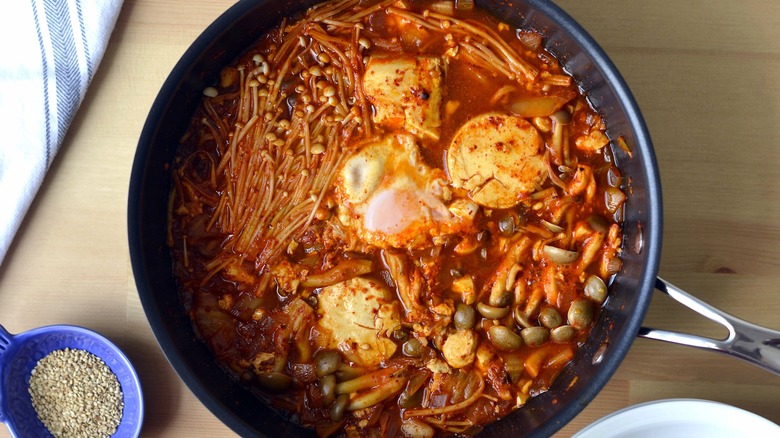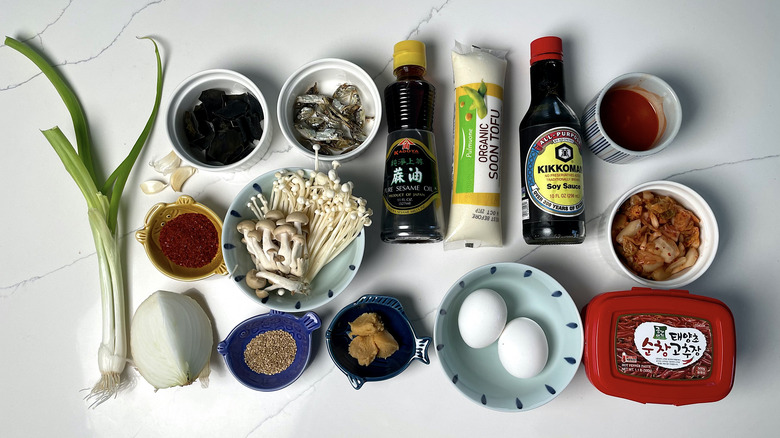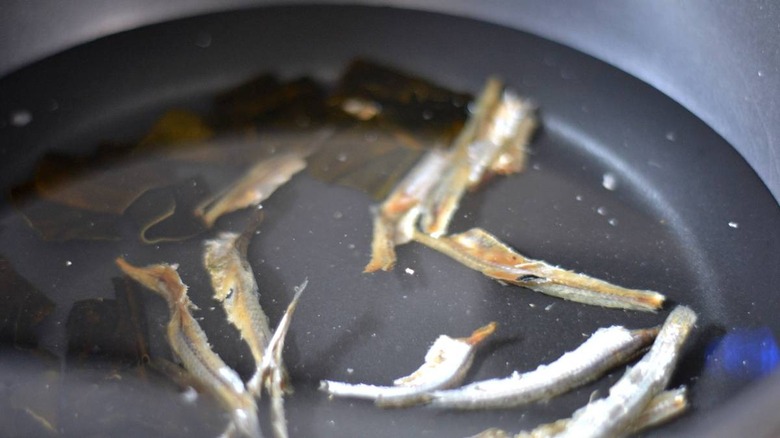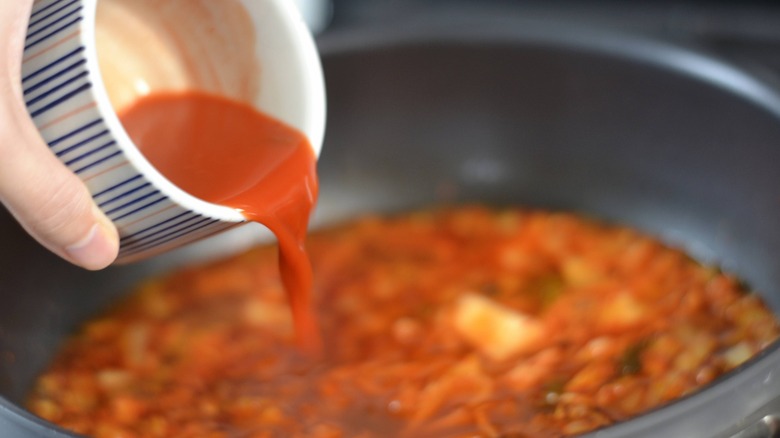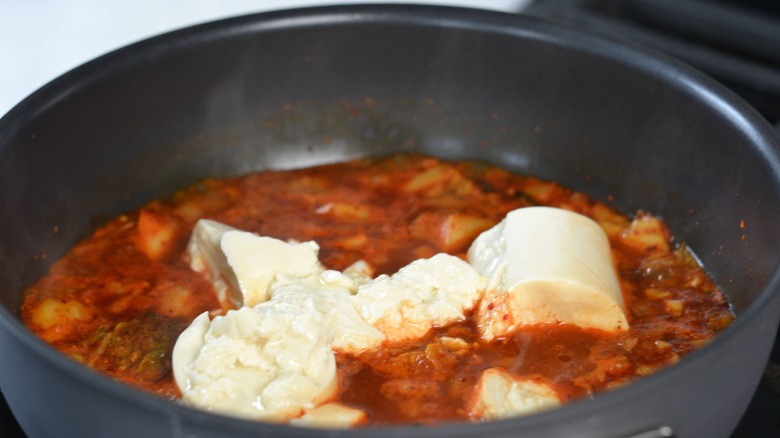Kimchi Sundubu Jjigae (Korean Tofu Stew) Recipe
Many of us, in our starving student years, subsisted on a diet of microwave popcorn and the type of instant ramen that can be bought for under a buck, but recipe developer Rika Hoffman preferred a slightly more elaborate meal. She says she opted for tofu, mushrooms, and kimchi cooked with various Asian seasonings and served with a side of rice. (David Chang also feels that Korean stew should be eaten with rice on the side.) While that meal took no more than 10 minutes to make (plus a bit longer for the rice), she describes the upgraded version of that kimchi sundubu jjigaes presented here as "slightly more laborious, but much more complex in flavor."
This dish, Hoffman says, is a fairly spicy one, telling us, "The kimchi flavors are bolstered with the addition of gochugaru and gochujang," although you can adjust the heat level up or down by adding or subtracting chile flakes to suit your own personal preference. The miso, she says, "helps give a lot of depth and body to this soup," while the sesame oil "adds a whiff of warm nuttiness."
Collect the ingredients for the kimchi sundubu jjigae (Korean tofu stew)
This tofu stew recipe starts off with a broth made of dried anchovies and kelp. Additional flavoring elements include onion, garlic, gochugaru, kimchi (complete with the juice), soy sauce, gochujang, and miso, along with a small amount of neutral oil for cooking. For the tofu, Hoffman likes to use the extra-soft kind called sundubu or soon tofu, but tells us that the regular kind of soft tofu sold in blocks can be used if that's easier to find.
Hoffman likes to use a combination of enoki and shimeji mushrooms in this stew. She then finishes off the soup with sesame oil and chopped scallions (aka green onions).
Make the anchovy-kelp stock
Both of the ingredients in this stock need to be prepped before the cooking can commence. First, take a damp towel (paper or cloth) and wipe off the kelp, then chop the heads off the anchovies. Split their bodies open the long way, then take out the dark-colored guts. Both heads and guts can be composted, as you won't be needing them again.
Put the dried fish and seaweed into a pot with the water and let them soak for at least half an hour, although an overnight soak would work, as well. After this waiting period is up, boil the soaking water, complete with kelp and anchovies, for 15 minutes on medium-high heat. Strain out the solids, then boil the broth alone for 15 more minutes. There's no need to cover the cooking pot at this point, although you will need a lid (or a makeshift one made of foil) at a later stage in the recipe.
Add some additional flavor to the broth
Pour the neutral oil into a frying pan and set the burner to medium, then fry the onion and garlic just until you can smell them (don't let them brown). Add the gochugaru and cook it for a minute, then stir in the kimchi and keep stirring and cooking it for a minute longer. Pour in the soup stock and add the kimchi juice and soy sauce, then bring the soup to a boil. Once it's boiling, stir in the gochujang and miso paste.
Hoffman advises to "taste as you go" while making the stew. One suggestion she has is that if over-fermented kimchi makes it too tangy, you can stir in ½ teaspoon of sugar to balance it out. She also notes that the gochugaru levels can be adjusted as desired, so feel free to start low (or omit) if you don't care for heat, or to add more if you do.
The tofu and mushrooms go in last
Put the tofu in the pot — et voilà! You've transformed the broth into something a bit more stew-like. Hoffman does say, though, "The flavor of the broth will be slightly diluted after adding the soft tofu." Toss in the mushrooms, too — and if you're using an optional egg or two, crack those in, as well. Put a lid on the pot and cook the stew for a few minutes. Once it's done and you've turned off the stove, sprinkle the sesame oil and scallions over the top. You can also garnish the dish with sesame seeds if you wish.
Hoffman says that this tofu stew will last in the refrigerator for up to 4 days. You'd better plan to eat it within that time frame, though, as she tells us that the tofu component prevents the stew from being frozen.
Kimchi Sundubu Jjigae (Korean Tofu Stew) Recipe
This kimchi sundubu jjiage features an adjustably spicy broth enriched with deep, rich miso and nutty sesame oil notes.
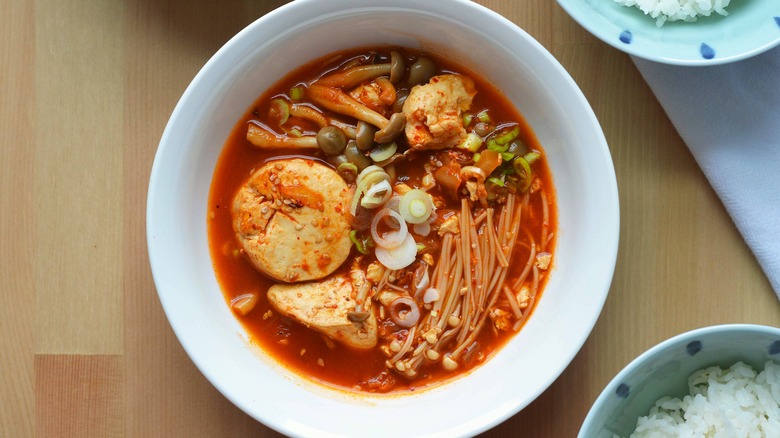
Ingredients
- ½ ounce dried kelp (approximately 8x3 inches)
- 10 large dried anchovies (about 3-inches long)
- 4 ½ cups water
- ¼ large onion, chopped
- 3 cloves garlic, minced
- 1 ½ teaspoon neutral oil
- 1 ½ tablespoon coarse gochugaru
- ½ cup kimchi, chopped
- 4 tablespoons kimchi juice
- ½ tablespoon soy sauce
- 1 ½ tablespoon gochujang
- 1 tablespoon miso
- 11 ounces soon tofu
- 3 ounces enoki mushrooms
- 3 ounces shimeji mushrooms
- 1 teaspoon sesame oil
- 2 scallions
Optional Ingredients
- 2 eggs
- ½ teaspoon sesame seeds
Directions
- Wipe the kelp with a damp cloth or paper towel.
- Remove the heads from each anchovy and split the bodies lengthwise to remove the dark innards.
- Soak the kelp and anchovies in the water for at least 30 minutes or up to overnight.
- Boil the kelp, anchovies, and soaking water on medium-high heat for 15 minutes in an uncovered pot.
- Remove the kelp and anchovies with a strainer and boil the water for another 15 minutes.
- Fry the onion and garlic in the neutral oil over medium heat until fragrant.
- Sprinkle the gochugaru into the pan and cook it for a minute, then add the kimchi and stir-fry it for a minute.
- Add the soup stock, kimchi juice, and soy sauce to the pot and bring the mixture to a boil.
- Stir the gochujang and miso paste into the broth.
- Add the tofu and simmer the stew on medium-low until it's heated through.
- Add the mushrooms to the broth (along with the optional eggs, if using), then cover the pot and cook everything for several minutes.
- Drizzle the tofu stew with sesame oil and sprinkle it with scallions (plus optional sesame seeds, if using) before eating.
Nutrition
| Calories per Serving | 437 |
| Total Fat | 21.1 g |
| Saturated Fat | 3.7 g |
| Trans Fat | 0.0 g |
| Cholesterol | 63.8 mg |
| Total Carbohydrates | 22.9 g |
| Dietary Fiber | 6.8 g |
| Total Sugars | 5.2 g |
| Sodium | 3,989.4 mg |
| Protein | 43.0 g |
